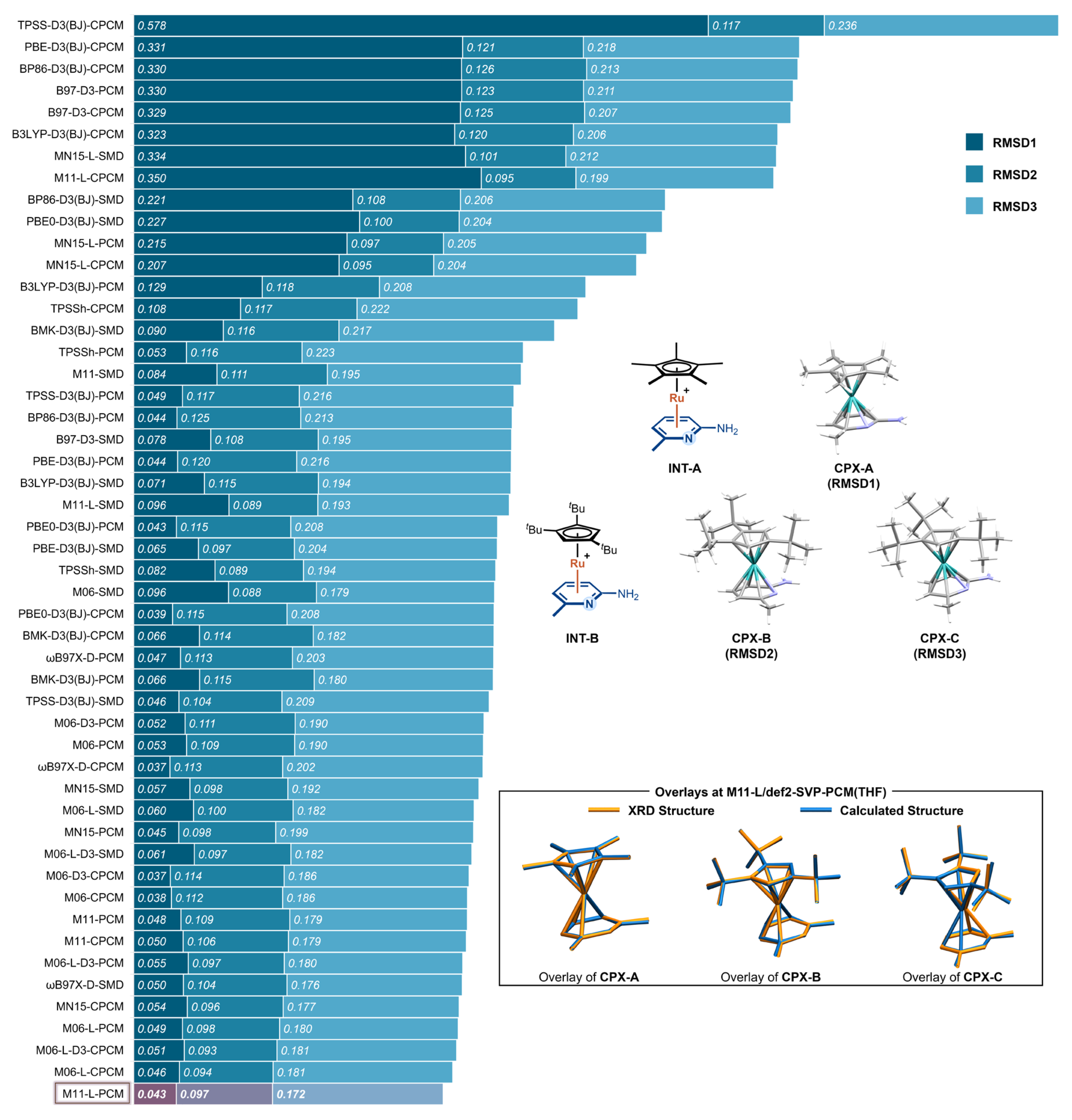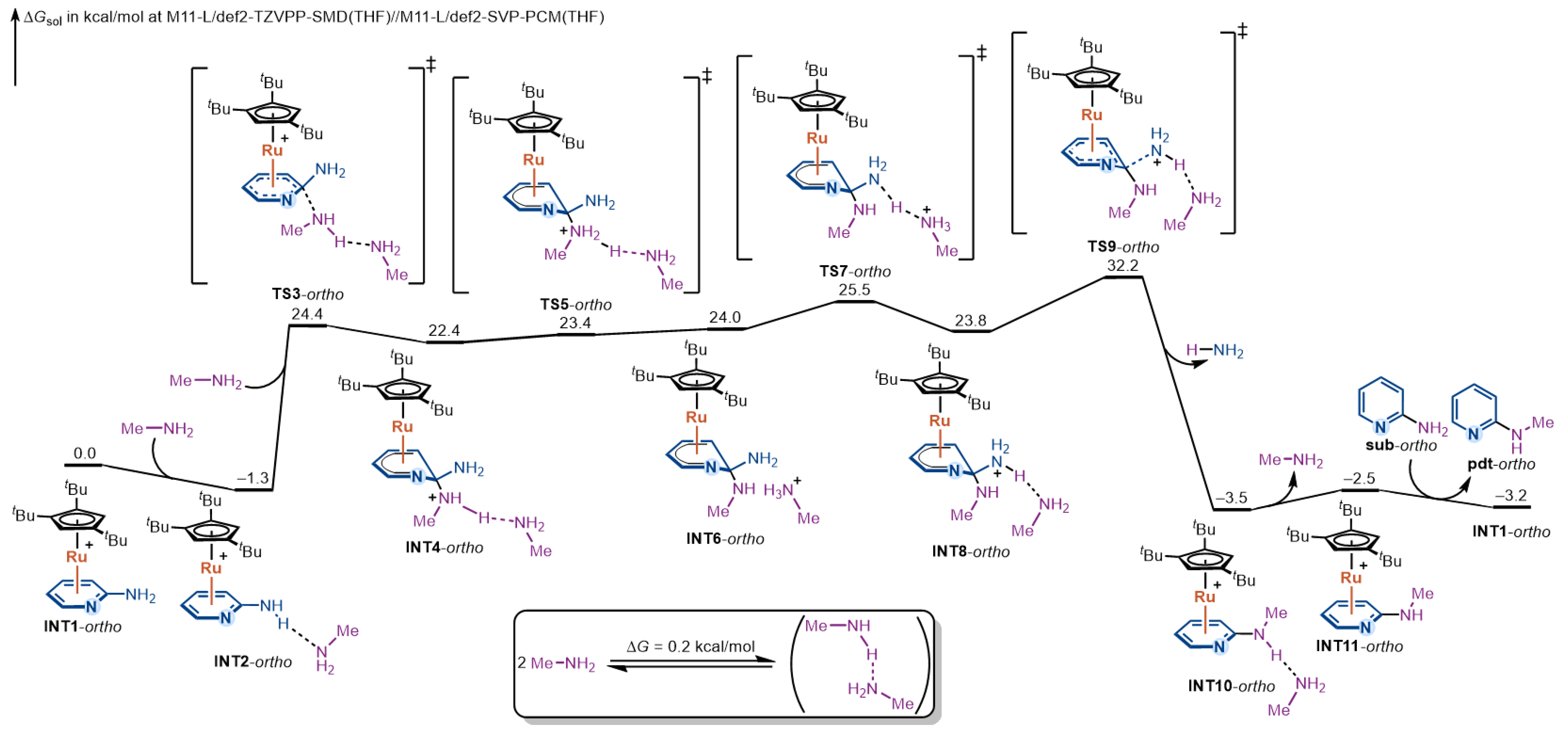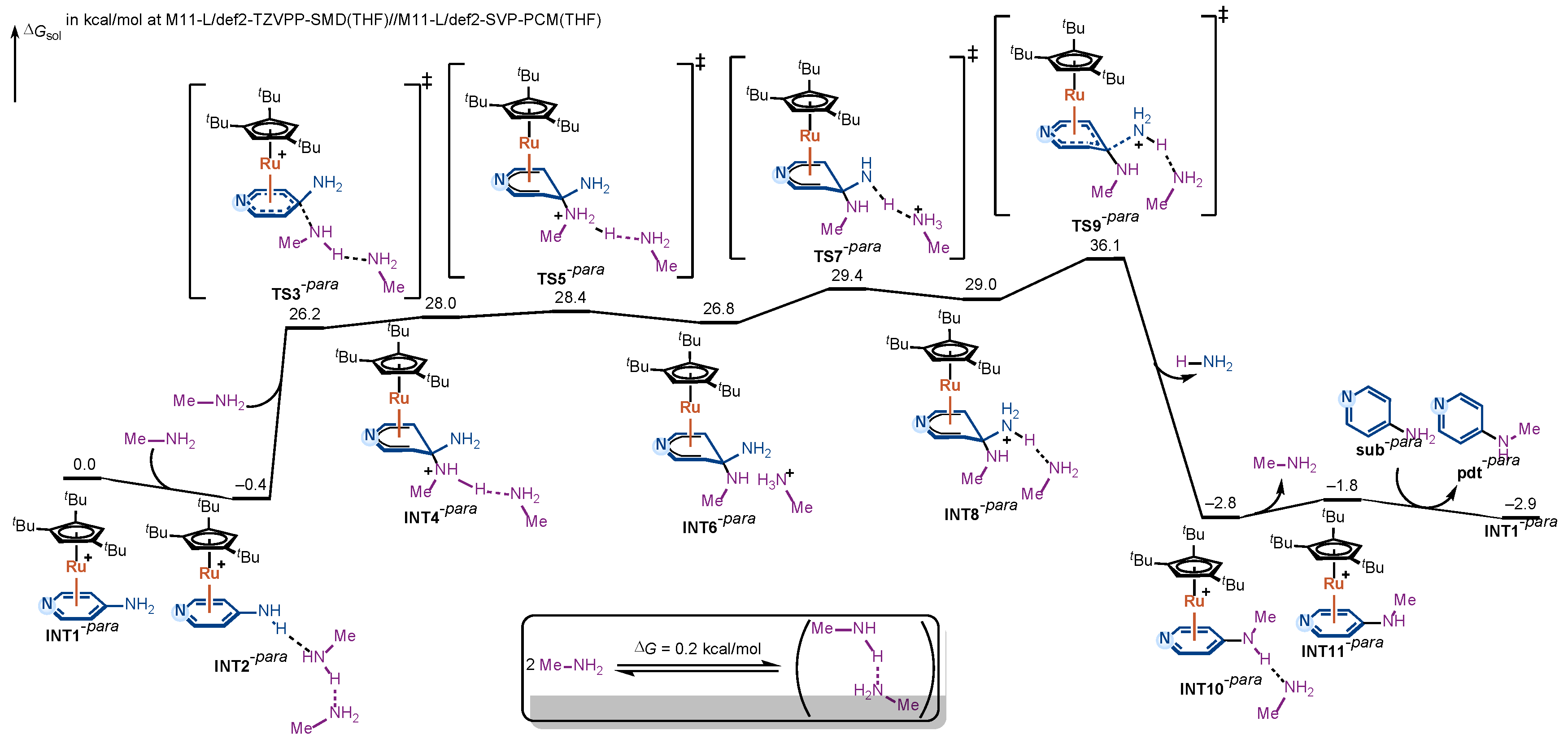Theoretical Study on the Ortho–Para Reactivity Difference in Ru-Catalyzed Amination of Aminopyridines via η6-Coordination: Role of Meisenheimer Intermediate Coordination Ability
Abstract
1. Introduction
2. Results and Discussion
2.1. Benchmarking Computational Methods for Ru(II)–Aminopyridine π-Complexes
2.2. DFT-Computed Mechanistic Profile for the Ortho-Substitution Pathway
2.3. DFT-Computed Mechanistic Profile for the Para-Substitution Pathway
2.4. Energy Decomposition Analysis of Meisenheimer Intermediate Stability
3. Materials and Methods
4. Conclusions
Supplementary Materials
Author Contributions
Funding
Institutional Review Board Statement
Informed Consent Statement
Data Availability Statement
Acknowledgments
Conflicts of Interest
References
- Zhu, H.; Wu, Y.; Mao, J.; Xu, J.; Walsh, P.J.; Shi, H. C–H functionalization through benzylic deprotonation with π-coordination or cation–π-interactions. Chem. Soc. Rev. 2025, 54, 2520–2542. [Google Scholar]
- Williams, L.J.; Bhonoah, Y.; Wilkinson, L.A.; Walton, J.W. As Nice as π: Aromatic Reactions Activated by π-Coordination to Transition Metals. Chem. Eur. J. 2021, 27, 3650–3660. [Google Scholar] [CrossRef]
- Litvak, V.V.; Kun, P.P.; Shteingarts, V.D. Arene transition metal complexes in reactions with nucleophilic reagents: XIX. Transannular substituent effects in arene-chromium and iron complexes. J. Organomet. Chem. 1988, 348, 219–233. [Google Scholar] [CrossRef]
- Utsunomiya, M.; Hartwig, J.F. Ruthenium-Catalyzed Anti-Markovnikov Hydroamination of Vinylarenes. J. Am. Chem. Soc. 2004, 126, 2702–2703. [Google Scholar] [CrossRef] [PubMed]
- Takaya, J.; Hartwig, J.F. Mechanistic Studies of Ruthenium-Catalyzed Anti-Markovnikov Hydroamination of Vinylarenes: Intermediates and Evidence for Catalysis through π-Arene Complexes. J. Am. Chem. Soc. 2005, 127, 5756–5757. [Google Scholar] [CrossRef]
- Otsuka, M.; Endo, K.; Shibata, T. Catalytic SNAr reaction of non-activated fluoroarenes with amines via Ru η6-arene complexes. Chem. Commun. 2010, 46, 336–338. [Google Scholar] [CrossRef]
- Walton, J.W.; Williams, J.M.J. Catalytic SNAr of unactivated aryl chlorides. Chem. Commun. 2015, 51, 2786–2789. [Google Scholar] [CrossRef]
- Konovalov, A.I.; Gorbacheva, E.O.; Miloserdov, F.M.; Grushin, V.V. Ruthenium-catalyzed nucleophilic fluorination of halobenzenes. Chem. Commun. 2015, 51, 13527–13530. [Google Scholar] [CrossRef]
- Takemoto, S.; Shibata, E.; Nakajima, M.; Yumoto, Y.; Shimamoto, M.; Matsuzaka, H. Ruthenium-Sulfonamide-Catalyzed Direct Dehydrative Condensation of Benzylic C–H Bonds with Aromatic Aldehydes. J. Am. Chem. Soc. 2016, 138, 14836–14839. [Google Scholar] [CrossRef] [PubMed]
- Kang, Q.-K.; Lin, Y.; Li, Y.; Shi, H. Ru(II)-Catalyzed Amination of Aryl Fluorides via η6-Coordination. J. Am. Chem. Soc. 2020, 142, 3706–3711. [Google Scholar] [CrossRef] [PubMed]
- Kang, Q.-K.; Lin, Y.; Li, Y.; Xu, L.; Li, K.; Shi, H. Catalytic SNAr Hydroxylation and Alkoxylation of Aryl Fluorides. Angew. Chem. Int. Ed. 2021, 60, 20391–20399. [Google Scholar] [CrossRef] [PubMed]
- Chen, K.; Kang, Q.-K.; Li, Y.; Wu, W.-Q.; Zhu, H.; Shi, H. Catalytic Amination of Phenols with Amines. J. Am. Chem. Soc. 2022, 144, 1144–1151. [Google Scholar] [CrossRef]
- Kang, Q.-K.; Li, Y.; Chen, K.; Zhu, H.; Wu, W.-Q.; Lin, Y.; Shi, H. Rhodium-Catalyzed Stereoselective Deuteration of Benzylic C–H Bonds via Reversible η6-Coordination. Angew. Chem. Int. Ed. 2022, 61, e202117381. [Google Scholar] [CrossRef]
- Wu, W.-Q.; Lin, Y.; Li, Y.; Shi, H. Catalytic Dehydrogenative (3 + 2) Cycloaddition of Alkylbenzenes via π-Coordination. J. Am. Chem. Soc. 2023, 145, 9464–9470. [Google Scholar] [CrossRef]
- Schulte, T.; Wang, Z.; Li, C.-C.; Hamad, A.; Waldbach, F.; Pampel, J.; Petzold, R.; Leutzsch, M.; Bahns, F.; Ritter, T. Ruthenium Phenoxo Complexes: An Isolobal Ligand to Cp with Improved Properties. J. Am. Chem. Soc. 2024, 146, 15825–15832. [Google Scholar] [CrossRef]
- Li, Y.; Shi, H. Rhodium-catalyzed addition reactions of benzylic C–H bonds to cyclic N-sulfonyl ketimines via π-coordination. Chin. Chem. Lett. 2024, 35, 108650. [Google Scholar] [CrossRef]
- Chen, K.; Shi, H. Nucleophilic Aromatic Substitution of Halobenzenes and Phenols with Catalysis by Arenophilic π Acids. Acc. Chem. Res. 2024, 57, 2194–2206. [Google Scholar] [CrossRef] [PubMed]
- Chen, J.; Lin, Y.; Wu, W.Q.; Hu, W.Q.; Xu, J.; Shi, H. Amination of Aminopyridines via η6-Coordination Catalysis. J. Am. Chem. Soc. 2024, 146, 22906–22912. [Google Scholar] [CrossRef]
- Becke, A.D. Density-functional exchange-energy approximation with correct asymptotic behavior. Phys. Rev. A 1988, 38, 3098–3100. [Google Scholar] [CrossRef]
- Grimme, S.; Antony, J.; Ehrlich, S.; Krieg, H. A consistent and accurate ab initio parametrization of density functional dispersion correction (DFT-D) for the 94 elements H-Pu. J. Chem. Phys. 2010, 132, 154104. [Google Scholar] [CrossRef] [PubMed]
- Grimme, S.; Ehrlich, S.; Goerigk, L. Effect of the damping function in dispersion corrected density functional theory. J. Comp. Chem. 2011, 32, 1456–1465. [Google Scholar] [CrossRef]
- Becke, A.D. Density-functional thermochemistry. III. The role of exact exchange. J. Chem. Phys. 1993, 98, 5648–5652. [Google Scholar] [CrossRef]
- Perdew, J.P.; Burke, K.; Ernzerhof, M. Generalized Gradient Approximation Made Simple. Phys. Rev. Lett. 1997, 78, 1396. [Google Scholar] [CrossRef]
- Adamo, C.; Barone, V. Toward reliable density functional methods without adjustable parameters: The PBE0 model. J. Chem. Phys. 1999, 110, 6158–6169. [Google Scholar] [CrossRef]
- Becke, A.D. Density-functional thermochemistry. V. Systematic optimization of exchange-correlation functionals. J. Chem. Phys. 1997, 107, 8554–8560. [Google Scholar] [CrossRef]
- Zhao, Y.; Truhlar, D.G. The M06 suite of density functionals for main group thermochemistry, thermochemical kinetics, noncovalent interactions, excited states, and transition elements: Two new functionals and systematic testing of four M06-class functionals and 12 other functionals. Theor. Chem. Acc. 2008, 120, 215–241. [Google Scholar]
- Zhao, Y.; Truhlar, D.G. A new local density functional for main-group thermochemistry, transition metal bonding, thermochemical kinetics, and noncovalent interactions. J. Chem. Phys. 2006, 125, 194101. [Google Scholar] [CrossRef]
- Yu, H.S.; He, X.; Li, S.L.; Truhlar, D.G. MN15: A Kohn–Sham global-hybrid exchange–correlation density functional with broad accuracy for multi-reference and single-reference systems and noncovalent interactions. Chem. Sci. 2016, 7, 5032–5051. [Google Scholar] [CrossRef]
- Yu, H.S.; He, X.; Truhlar, D.G. MN15-L: A New Local Exchange-Correlation Functional for Kohn–Sham Density Functional Theory with Broad Accuracy for Atoms, Molecules, and Solids. J. Chem. Theo. Comput. 2016, 12, 1280–1293. [Google Scholar] [CrossRef]
- Peverati, R.; Truhlar, D.G. Improving the Accuracy of Hybrid Meta-GGA Density Functionals by Range Separation. J. Phys. Chem. Lett. 2011, 2, 2810–2817. [Google Scholar] [CrossRef]
- Peverati, R.; Truhlar, D.G. M11-L: A Local Density Functional That Provides Improved Accuracy for Electronic Structure Calculations in Chemistry and Physics. J. Phys. Chem. Lett. 2012, 3, 117–124. [Google Scholar] [CrossRef]
- Boese, A.D.; Martin, J.M.L. Development of density functionals for thermochemical kinetics. J. Chem. Phys. 2004, 121, 3405–3416. [Google Scholar] [CrossRef]
- Tao, J.M.; Perdew, J.P.; Staroverov, V.N.; Scuseria, G.E. Climbing the Density Functional Ladder: Nonempirical Meta–Generalized Gradient Approximation Designed for Molecules and Solids. Phys. Rev. Lett. 2003, 91, 146401. [Google Scholar] [CrossRef] [PubMed]
- Staroverov, V.N.; Scuseria, G.E.; Tao, J.M.; Perdew, J.P. Comparative assessment of a new nonempirical density functional: Molecules and hydrogen-bonded complexes. J. Chem. Phys. 2003, 119, 12129. [Google Scholar] [CrossRef]
- Chai, J.D.; Head-Gordon, M. Long-range corrected hybrid density functionals with damped atom–atom dispersion corrections. Phys. Chem. Chem. Phys. 2008, 10, 6615–6620. [Google Scholar] [CrossRef]
- Lu, T.; Chen, Q. Simple, Efficient, and Universal Energy Decomposition Analysis Method Based on Dispersion-Corrected Density Functional Theory. J. Phys. Chem. A 2023, 127, 7023. [Google Scholar] [CrossRef]
- Frisch, M.J.; Trucks, G.W.; Schlegel, H.B.; Scuseria, G.E.; Robb, M.A.; Cheeseman, J.R.; Scalmani, G.; Barone, V.; Petersson, G.A.; Nakatsuji, H.; et al. Gaussian 16, Revision A.03; Gaussian, Inc.: Wallingford, CT, USA, 2016.
- Lu, T.; Chen, F. Multiwfn: A multifunctional wavefunction analyzer. J. Comput. Chem. 2012, 33, 580–592. [Google Scholar] [CrossRef]
- Legault, C.Y. CYLView, version 1.0b; Universitéde Sherbrooke: Montreal, QC, Canada, 2009. Available online: http://www.cylview.org (accessed on 1 January 2025).
- Kuntz, R.; Yan, Y.; Sigman, M.S.; Sanford, M.S. A Physical Organic Chemistry Approach to Developing Cyclopropenium-Based Energy Storage Materials for Redox Flow Batteries. Acc. Chem. Res. 2023, 56, 1239–1250. [Google Scholar] [CrossRef] [PubMed]
- Qian, G.; Zhu, L.; Zeng, Y.; Li, J.; Liu, J.; Fei, C.; Li, Z.; Zhang, S.; Luo, J.; Deng, L.; et al. Mechanism and Origins of Weak Bonding-Controlled Selectivities in Cinchoninium-Catalyzed Umpolung Michael Addition of Imines. CCS Chem. 2025, 7, 1797–1811. [Google Scholar] [CrossRef]





Disclaimer/Publisher’s Note: The statements, opinions and data contained in all publications are solely those of the individual author(s) and contributor(s) and not of MDPI and/or the editor(s). MDPI and/or the editor(s) disclaim responsibility for any injury to people or property resulting from any ideas, methods, instructions or products referred to in the content. |
© 2025 by the authors. Licensee MDPI, Basel, Switzerland. This article is an open access article distributed under the terms and conditions of the Creative Commons Attribution (CC BY) license (https://creativecommons.org/licenses/by/4.0/).
Share and Cite
Wang, C.; Zhang, S.-Q.; Hong, X. Theoretical Study on the Ortho–Para Reactivity Difference in Ru-Catalyzed Amination of Aminopyridines via η6-Coordination: Role of Meisenheimer Intermediate Coordination Ability. Inorganics 2025, 13, 316. https://doi.org/10.3390/inorganics13100316
Wang C, Zhang S-Q, Hong X. Theoretical Study on the Ortho–Para Reactivity Difference in Ru-Catalyzed Amination of Aminopyridines via η6-Coordination: Role of Meisenheimer Intermediate Coordination Ability. Inorganics. 2025; 13(10):316. https://doi.org/10.3390/inorganics13100316
Chicago/Turabian StyleWang, Cheng, Shuo-Qing Zhang, and Xin Hong. 2025. "Theoretical Study on the Ortho–Para Reactivity Difference in Ru-Catalyzed Amination of Aminopyridines via η6-Coordination: Role of Meisenheimer Intermediate Coordination Ability" Inorganics 13, no. 10: 316. https://doi.org/10.3390/inorganics13100316
APA StyleWang, C., Zhang, S.-Q., & Hong, X. (2025). Theoretical Study on the Ortho–Para Reactivity Difference in Ru-Catalyzed Amination of Aminopyridines via η6-Coordination: Role of Meisenheimer Intermediate Coordination Ability. Inorganics, 13(10), 316. https://doi.org/10.3390/inorganics13100316





